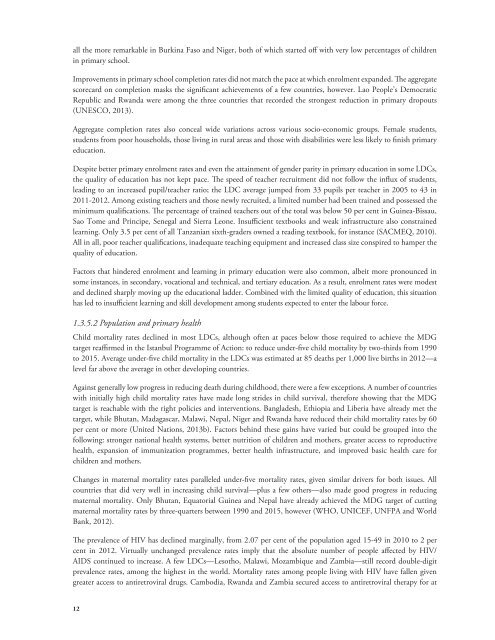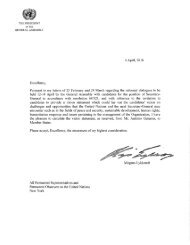State-of-the-Least-Developed-Countries-Report-2014
State-of-the-Least-Developed-Countries-Report-2014
State-of-the-Least-Developed-Countries-Report-2014
Create successful ePaper yourself
Turn your PDF publications into a flip-book with our unique Google optimized e-Paper software.
all <strong>the</strong> more remarkable in Burkina Faso and Niger, both <strong>of</strong> which started <strong>of</strong>f with very low percentages <strong>of</strong> children<br />
in primary school.<br />
Improvements in primary school completion rates did not match <strong>the</strong> pace at which enrolment expanded. The aggregate<br />
scorecard on completion masks <strong>the</strong> significant achievements <strong>of</strong> a few countries, however. Lao People’s Democratic<br />
Republic and Rwanda were among <strong>the</strong> three countries that recorded <strong>the</strong> strongest reduction in primary dropouts<br />
(UNESCO, 2013).<br />
Aggregate completion rates also conceal wide variations across various socio-economic groups. Female students,<br />
students from poor households, those living in rural areas and those with disabilities were less likely to finish primary<br />
education.<br />
Despite better primary enrolment rates and even <strong>the</strong> attainment <strong>of</strong> gender parity in primary education in some LDCs,<br />
<strong>the</strong> quality <strong>of</strong> education has not kept pace. The speed <strong>of</strong> teacher recruitment did not follow <strong>the</strong> influx <strong>of</strong> students,<br />
leading to an increased pupil/teacher ratio; <strong>the</strong> LDC average jumped from 33 pupils per teacher in 2005 to 43 in<br />
2011-2012. Among existing teachers and those newly recruited, a limited number had been trained and possessed <strong>the</strong><br />
minimum qualifications. The percentage <strong>of</strong> trained teachers out <strong>of</strong> <strong>the</strong> total was below 50 per cent in Guinea-Bissau,<br />
Sao Tome and Principe, Senegal and Sierra Leone. Insufficient textbooks and weak infrastructure also constrained<br />
learning. Only 3.5 per cent <strong>of</strong> all Tanzanian sixth-graders owned a reading textbook, for instance (SACMEQ, 2010).<br />
All in all, poor teacher qualifications, inadequate teaching equipment and increased class size conspired to hamper <strong>the</strong><br />
quality <strong>of</strong> education.<br />
Factors that hindered enrolment and learning in primary education were also common, albeit more pronounced in<br />
some instances, in secondary, vocational and technical, and tertiary education. As a result, enrolment rates were modest<br />
and declined sharply moving up <strong>the</strong> educational ladder. Combined with <strong>the</strong> limited quality <strong>of</strong> education, this situation<br />
has led to insufficient learning and skill development among students expected to enter <strong>the</strong> labour force.<br />
1.3.5.2 Population and primary health<br />
Child mortality rates declined in most LDCs, although <strong>of</strong>ten at paces below those required to achieve <strong>the</strong> MDG<br />
target reaffirmed in <strong>the</strong> Istanbul Programme <strong>of</strong> Action: to reduce under-five child mortality by two-thirds from 1990<br />
to 2015. Average under-five child mortality in <strong>the</strong> LDCs was estimated at 85 deaths per 1,000 live births in 2012—a<br />
level far above <strong>the</strong> average in o<strong>the</strong>r developing countries.<br />
Against generally low progress in reducing death during childhood, <strong>the</strong>re were a few exceptions. A number <strong>of</strong> countries<br />
with initially high child mortality rates have made long strides in child survival, <strong>the</strong>refore showing that <strong>the</strong> MDG<br />
target is reachable with <strong>the</strong> right policies and interventions. Bangladesh, Ethiopia and Liberia have already met <strong>the</strong><br />
target, while Bhutan, Madagascar, Malawi, Nepal, Niger and Rwanda have reduced <strong>the</strong>ir child mortality rates by 60<br />
per cent or more (United Nations, 2013b). Factors behind <strong>the</strong>se gains have varied but could be grouped into <strong>the</strong><br />
following: stronger national health systems, better nutrition <strong>of</strong> children and mo<strong>the</strong>rs, greater access to reproductive<br />
health, expansion <strong>of</strong> immunization programmes, better health infrastructure, and improved basic health care for<br />
children and mo<strong>the</strong>rs.<br />
Changes in maternal mortality rates paralleled under-five mortality rates, given similar drivers for both issues. All<br />
countries that did very well in increasing child survival—plus a few o<strong>the</strong>rs—also made good progress in reducing<br />
maternal mortality. Only Bhutan, Equatorial Guinea and Nepal have already achieved <strong>the</strong> MDG target <strong>of</strong> cutting<br />
maternal mortality rates by three-quarters between 1990 and 2015, however (WHO, UNICEF, UNFPA and World<br />
Bank, 2012).<br />
The prevalence <strong>of</strong> HIV has declined marginally, from 2.07 per cent <strong>of</strong> <strong>the</strong> population aged 15-49 in 2010 to 2 per<br />
cent in 2012. Virtually unchanged prevalence rates imply that <strong>the</strong> absolute number <strong>of</strong> people affected by HIV/<br />
AIDS continued to increase. A few LDCs—Lesotho, Malawi, Mozambique and Zambia—still record double-digit<br />
prevalence rates, among <strong>the</strong> highest in <strong>the</strong> world. Mortality rates among people living with HIV have fallen given<br />
greater access to antiretroviral drugs. Cambodia, Rwanda and Zambia secured access to antiretroviral <strong>the</strong>rapy for at<br />
12



